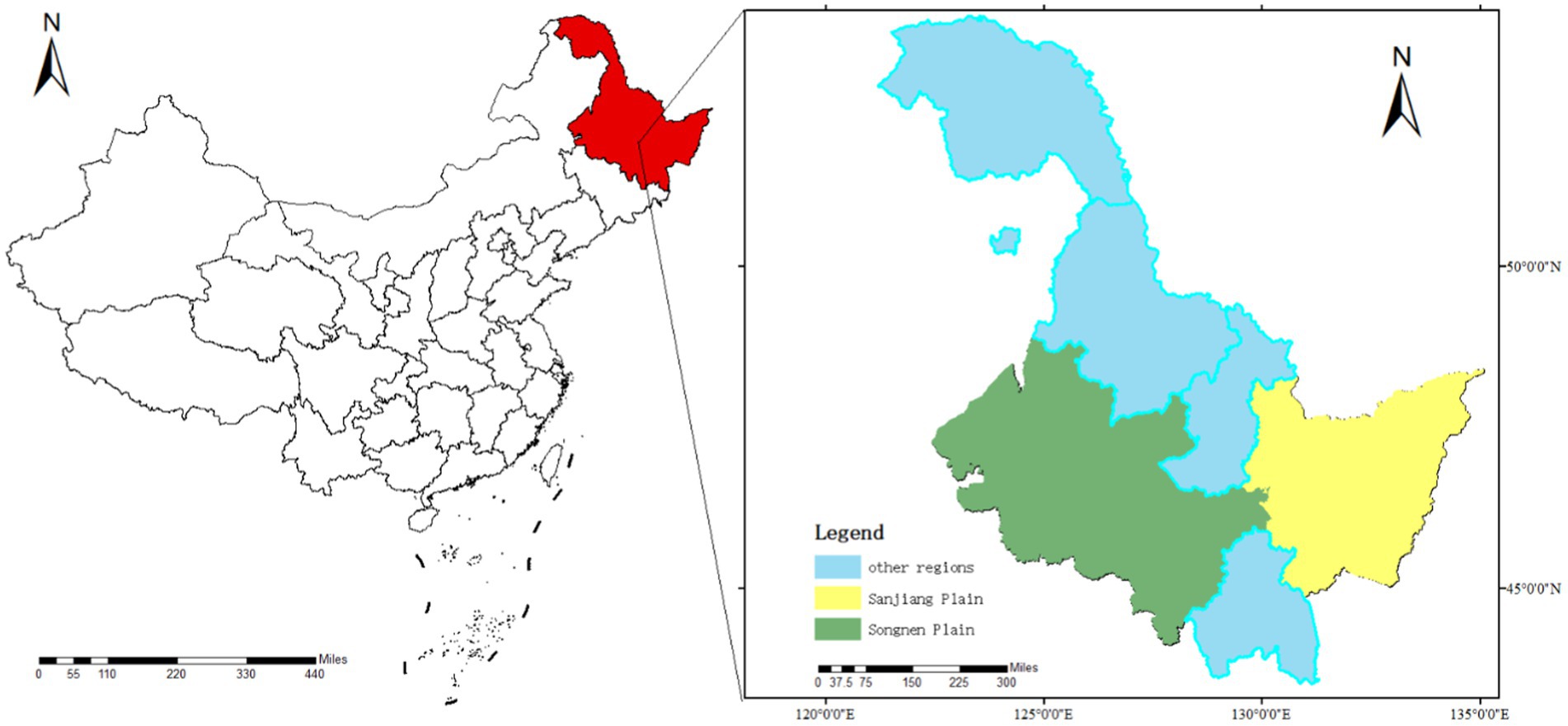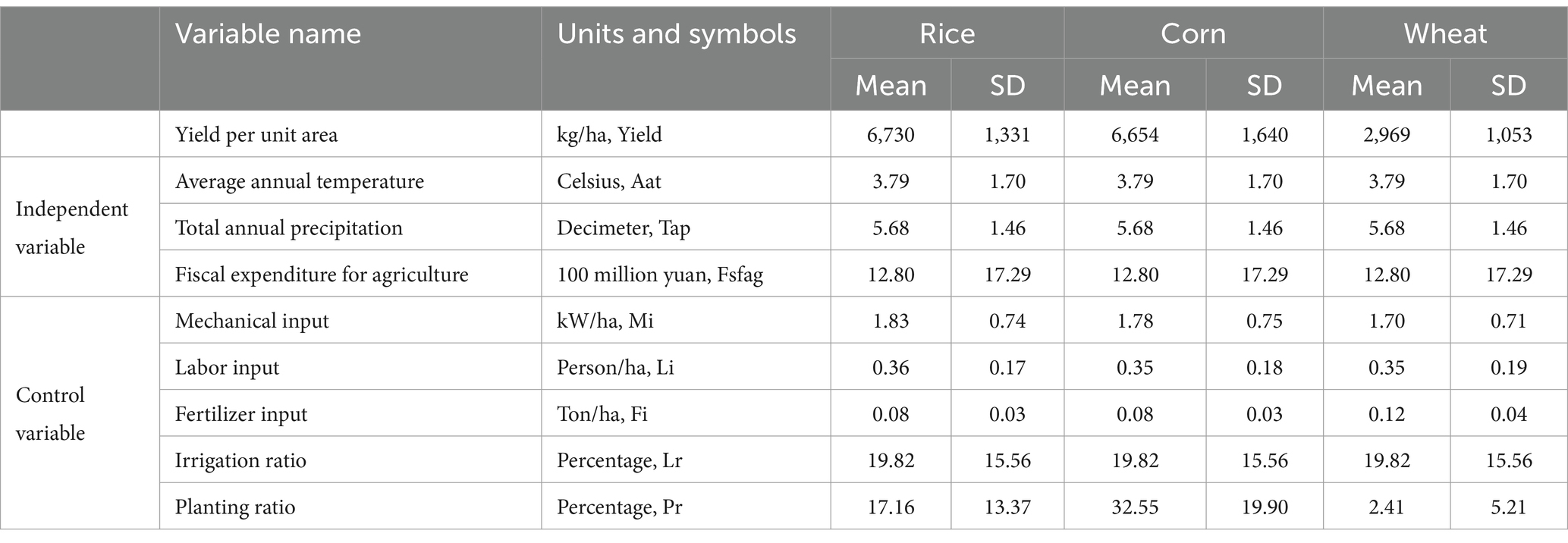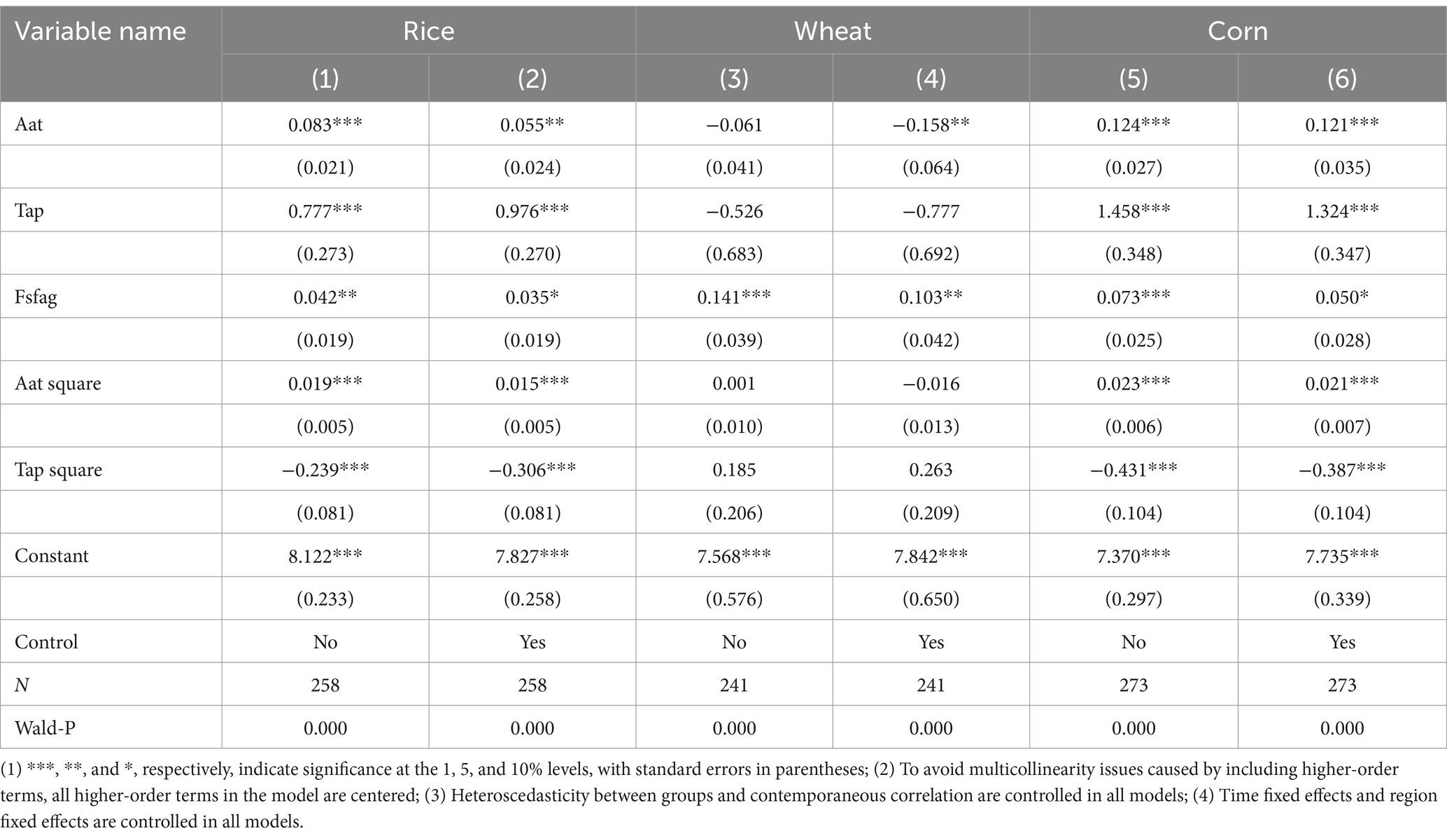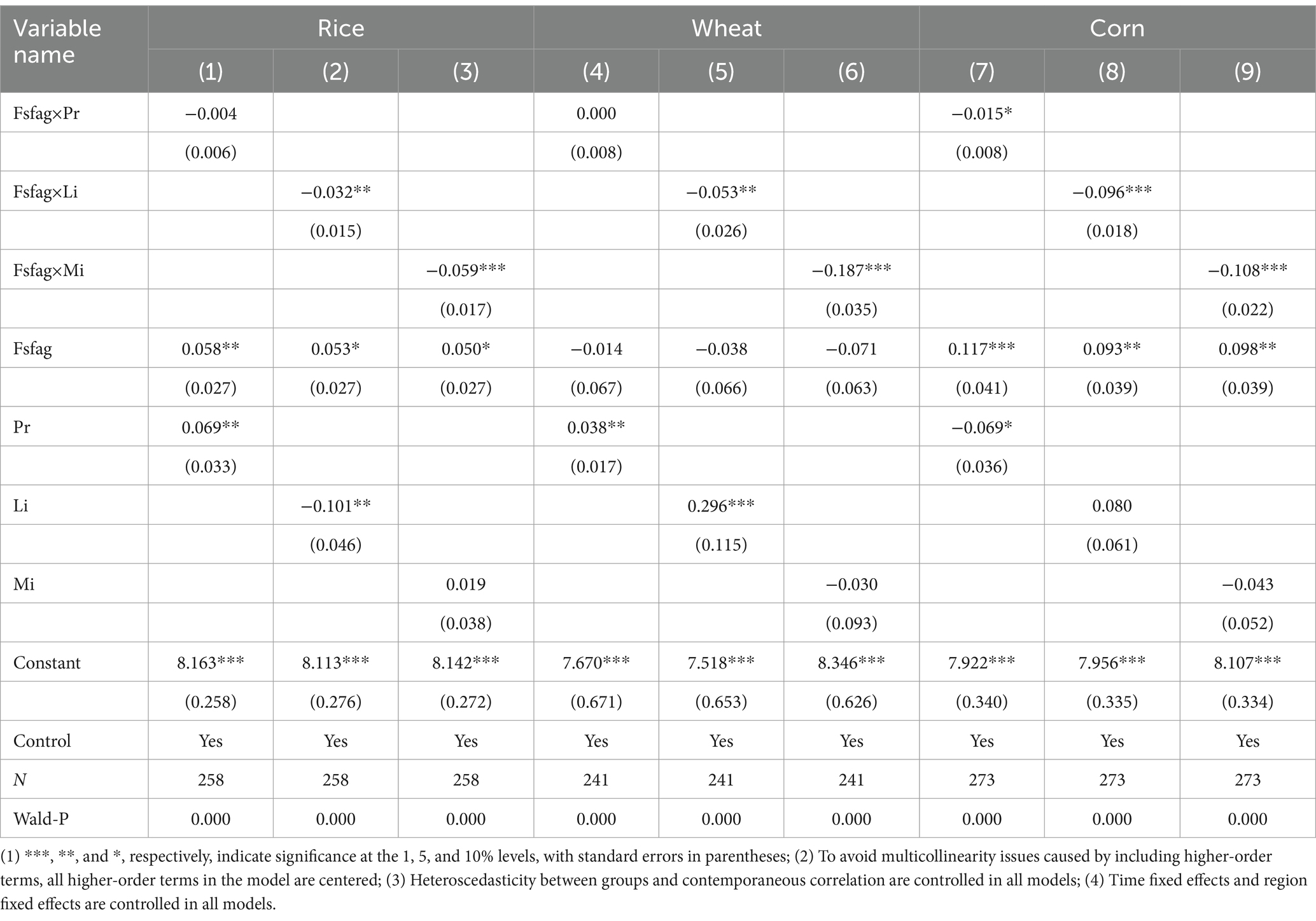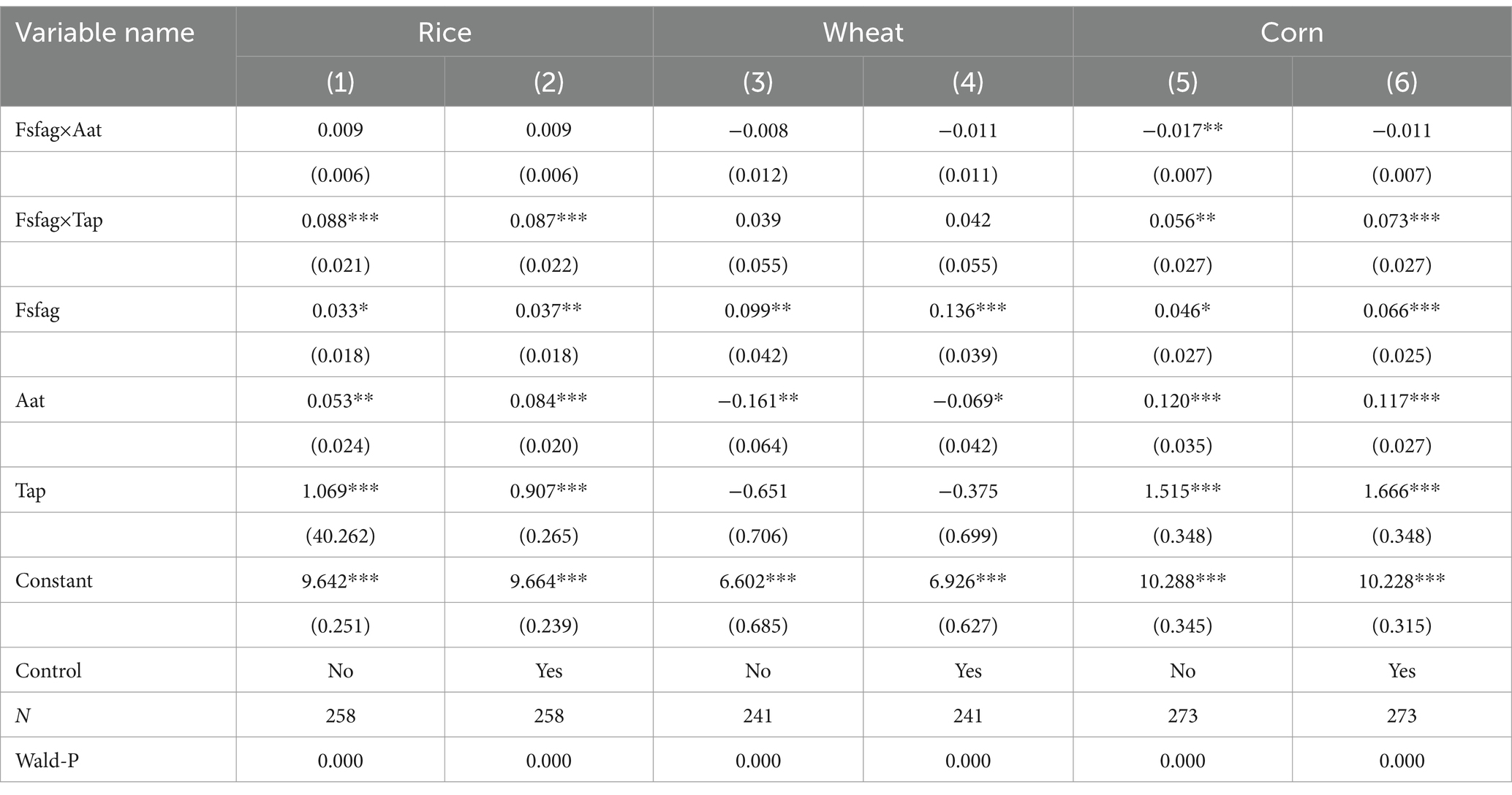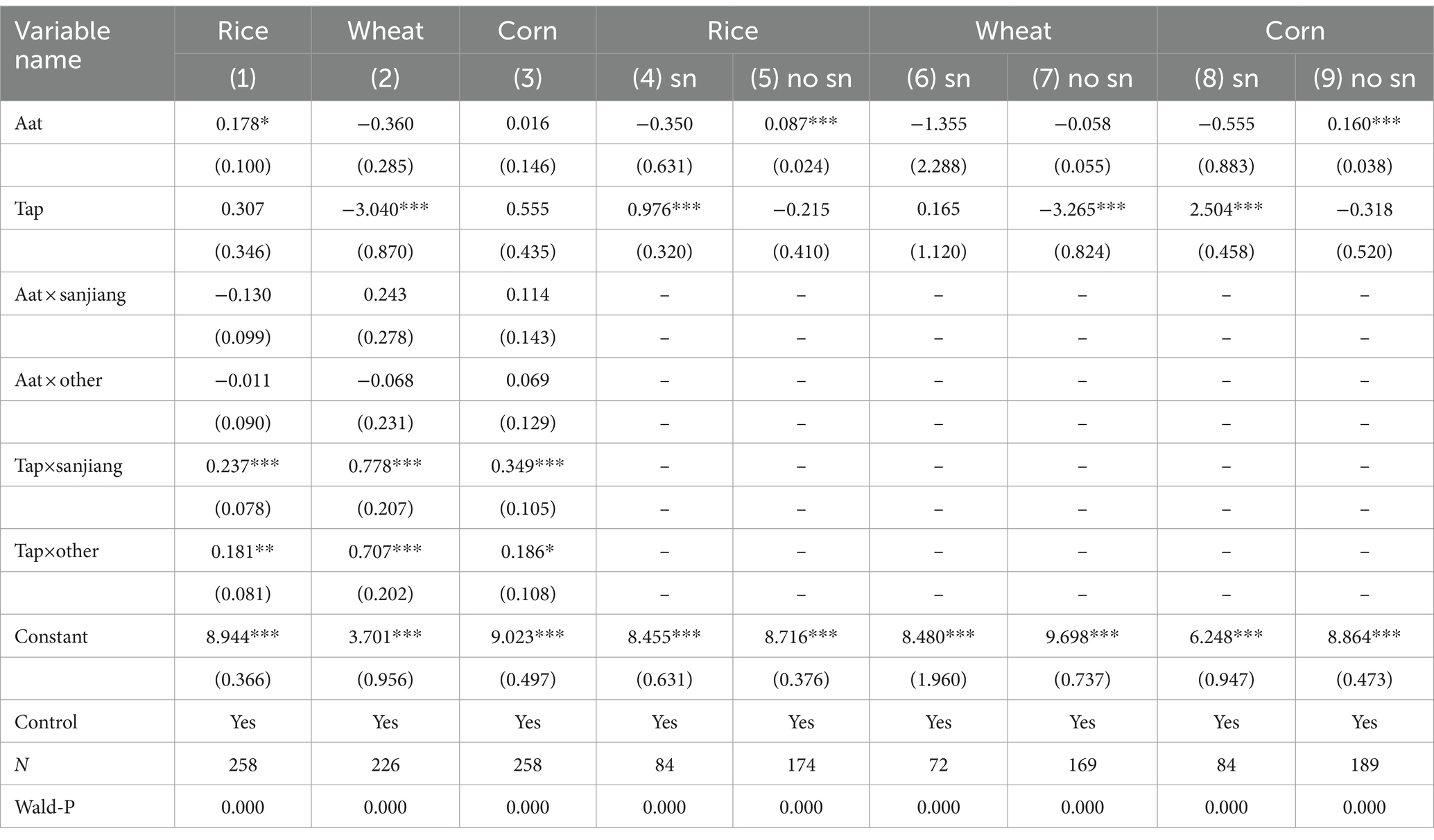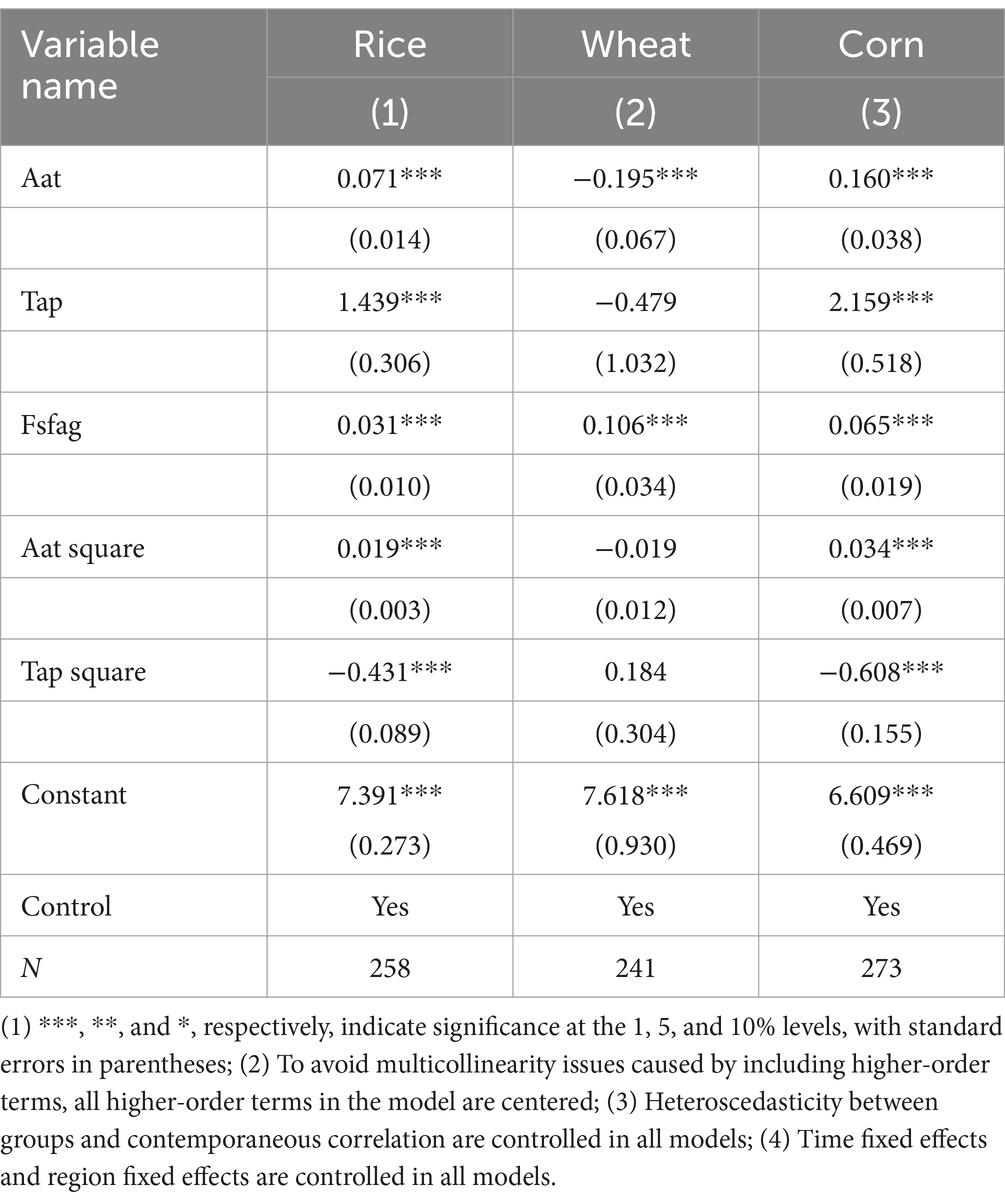- 1Institute of Agricultural Economics and Development, Chinese Academy of Agricultural Sciences, Beijing, China
- 2College of Economics and Management, Northwest A&F University, Xianyang, China
The profound impact of climate change on agricultural production, and the government’s fiscal expenditure for agriculture, is considered a crucial means to address this challenge. This study utilizes panel data from all prefecture-level cities in Heilongjiang Province from 2000 to 2020. Drawing upon the Cobb–Douglas production function, an economic climate model is constructed to empirically analyze the impact of climate change on grain yield in Heilongjiang Province. Furthermore, the role of fiscal expenditure for agriculture in mitigating the effects of climate change on grain yield is explored. Feasible Generalized Least Squares (FGLS) estimation is employed to address issues of “heteroscedasticity,” “autocorrelation within groups,” and “cross-sectional contemporaneous correlation” present in the model. The results indicate that climate change has a positive impact on rice and corn yields, while exhibiting a negative impact on wheat yield. The influence of climate change on crop yield is both linear and nonlinear. Specifically, temperature demonstrates a linear relationship with rice and corn yields, whereas precipitation shows a significant inverted U-shaped relationship with rice and corn yields. The impact of climate change on grain production in Heilongjiang Province varies significantly across regions. Fiscal expenditure for agriculture has a significant positive effect on the yield of major grain crops in Heilongjiang Province. In addressing the impact of climate change on grain production, agricultural fiscal expenditure enhances the positive effect of precipitation on rice and corn yields, while diminishing the positive impact of temperature on corn yield.
1 Introduction
The carbon emissions from the agricultural, livestock, and industrial sectors have a significant impact on climate change, posing a global critical challenge (Abbas et al., 2022a,b; Elahi et al., 2022, 2024). Climate change is one of the severe challenges facing the world today, and its impact on agriculture has attracted global attention (Chen et al., 2020). A plethora of research has indicated that climate change has profound effects on agricultural production (Schlenker and Roberts, 2009). The rise in global average temperatures, changes in precipitation patterns, and an increase in the frequency and intensity of extreme weather events have all significantly affected agricultural production (Schlenker and Lobell, 2010; Lobell and Gourdji, 2012; Wijeratne et al., 2022; Ullah et al., 2023). Without effective measures in the coming decades, climate change poses a serious threat to crop yields, food security, and agricultural livelihoods (Challinor et al., 2014; Ray et al., 2015). Meanwhile, as global climate change intensifies, Chinese agriculture faces formidable challenges, as climate change has notably impacted the growth cycles, yields, and quality of crops (Tao et al., 2015; Liu et al., 2016, 2020, 2021). Between 2000 and 2020, the annual average area of crops affected by droughts and floods in China reached 35.198 million hectares, accounting for 22.03% of the total sown area during the same period (“China Rural Statistical Yearbook—2021”, 2021). Frequent natural disasters induced by climate change significantly hinder sustainable agricultural development in China (Jia and Pan, 2016).
As the world’s largest agricultural producer, understanding the impact of climate change on Chinese agriculture holds profound significance. In recent years, scholars have conducted extensive research in this field. Numerous studies have found that climate change, particularly rising temperatures and changes in precipitation patterns, has significant impacts on the yield of Chinese staple crops. For instance, research has demonstrated that climate change has altered the yields of major cereal crops like wheat, rice, and maize over the past three decades. Despite advancements in agricultural technology that might mitigate some of the impacts, the threat of climate change to Chinese food security remains substantial (Tao et al., 2009). Projections suggest that climate change could lead to a 20% reduction in wheat, rice, and maize yields in China, with potential repercussions on international grain trade (Xuan et al., 2021).
Located in the northernmost part of China, Heilongjiang Province falls within the region of the black soil belt. As the country’s largest grain production and export base, the province accounted for 11.23% of the total grain output in 2020, maintaining its national leading position for 12 consecutive years. Due to its unique geographic position, Heilongjiang Province is both sensitive and significantly affected by climate change (Jiangbo et al., 2022). Over the past 50 years, the province’s warming rate has been as high as 0.4°C per decade (Jianying and Jianping, 2011), surpassing the national average of 0.25°C per decade during the same period (Lupeng et al., 2005). The sustained temperature rise has introduced uncertainty to grain production in the province, a subject that many scholars have deeply investigated. As one of China’s major grain-producing areas, and influenced significantly by a continental monsoon climate, Heilongjiang Province’s agriculture is exceptionally responsive to climate change (Lin et al., 2015). Its unique geographical position and climatic characteristics lead to distinctive patterns of climate change impact on agricultural yield in the province. For instance, research reveals that rising temperatures exhibit a dual influence on grain crop yields. On the one hand, temperature increase may shorten winter and advance spring, favoring the growth of crops like maize and soybeans. On the other hand, excessively high summer temperatures could negatively affect rice and other crops (Zhao et al., 2017). Simultaneously, changes in precipitation patterns could also considerably influence agricultural yields. Studies by Salazar et al. indicate that increased precipitation improves field moisture conditions, contributing to higher crop yields. However, excessive rainfall can lead to flooding, resulting in crop damage (Salazar et al., 2007).
The characteristics of agriculture, including its vulnerability, public nature, and externalities, emphasize the importance of governmental fiscal support for agriculture (Binlei and Shuo, 2021). These financial support policies, such as fund allocation, tax incentives, and price support, can influence the cost, income, and risk management of agricultural production, consequently having significant impacts (Tuanbiao and Lin, 2022). Research results suggest that enhancing agricultural infrastructure and providing agricultural insurance subsidies can alleviate the adverse effects of climate change on grain production (Juncong et al., 2016; Zhixin et al., 2022). Moreover, increasing investments in agricultural research contribute to improving crop adaptability and disaster resistance, thereby promoting long-term growth in grain yield (Evenson and Gollin, 2003; Salim and Islam, 2010; Chaojing et al., 2016; Bollington et al., 2021; Carter et al., 2021). Building upon the analysis of the impacts of climate change and agricultural research investment on agricultural production, Yi et al. further explore the role of agricultural research investment in mitigating the effects of climate change on agricultural production, confirming its positive contribution (Fujin et al., 2021). It should be noted that government support for agricultural production is primarily achieved through fiscal means, and the impact of agricultural fiscal support policies on agricultural production is not always positive. For example, investigations into subsidy programs in sub-Saharan Africa by Jayne et al. found that the costs of these projects generally outweigh their benefits (Jayne and Rashid, 2013). Other research has indicated that government agricultural subsidy policies might lead to excessive resource exploitation and environmental pollution, such as excessive use of fertilizers and pesticides (Wu et al., 2019; Gao et al., 2021). Additionally, the implementation of agricultural fiscal policies is influenced by various factors, and the effectiveness of these policies needs to be determined based on specific circumstances (De Janvry and Sadoulet, 2010). For example, in the context of Tanzania, Kawishe et al. discuss the political aspects of agricultural fiscal policy implementation and use qualitative research methods to reveal how political dynamics can render agricultural policy implementation ineffective (Kawishe and Mallya, 2022).
Existing studies highlight that both infrastructure development and agricultural research investment constitute crucial components of government agricultural fiscal policies. Fiscal expenditure for agriculture plays a positive role in promoting grain production, effectively mitigating the adverse effects of climate change, and better addressing the challenges of climate change (Yafen et al., 2015; Yixuan and Zhongjian, 2022). Although Zhu et al. analyze the impacts of climate change and fiscal expenditure for agriculture on agricultural output (Zhu Tiehui and Lei, 2012), they do not deeply explore the specific contribution of fiscal expenditure for agriculture in addressing climate change. Indeed, by integrating governmental actions and climate change into the same analytical framework, a more comprehensive understanding of the impact of climate change on agricultural production and the government’s role in addressing climate change can be achieved (Jieming et al., 2006; Alston et al., 2010). This not only enriches research on the impact of climate change on grain production but also aids in comprehending the efficiency of fiscal expenditure for agriculture. While many current studies use crop yield models to investigate the effects of climate change on grain yield, this approach might overestimate the impacts. Incorporating economic variables into the model can provide a more accurate estimation of the effects of climate change. It is worth noting that most studies only focus on the linear impact of climate change on grain production, neglecting research on nonlinear relationships. This oversight reduces the reliability and long-term predictive capability of the results. Consequently, investigating the nonlinear effects of climate change on grain production becomes especially important in future research on stable and increased grain production.
The significance of this study lies in its in-depth exploration of the extent to which agricultural production in Heilongjiang Province is affected by climate change and the role of fiscal expenditure for agriculture in mitigating this impact. Moreover, our work enriches and advances theoretical insights and empirical evidence in the field of climate change and food security, offering guiding significance for China’s efforts to tackle the challenges of global warming and achieve national food security goals. We analyze the relationship between climate change and agricultural production at the macro level, construct an economic climate model using the Cobb–Douglas production function, and utilize feasible generalized least squares to address heteroscedasticity, autocorrelation, and cross-sectional contemporaneous correlation in the model. This provides a novel approach to economic methods for studying the impact of climate change on agricultural production. Furthermore, we delve into the impacts of climate change on the yield of rice, maize, and wheat in Heilongjiang Province, uncovering the linear and nonlinear characteristics of climate change’s effects on crop yields and analyzing regional differences in the impact of climate change on grain production. The research findings enhance our accurate understanding and prediction of the impacts of climate change on agricultural production, providing policymakers with more targeted strategies. Additionally, we investigate the role of fiscal expenditure for agriculture in addressing the effects of climate change, which serves as a significant complement to current research. Although previous studies have highlighted the threats of climate change to agricultural production, explorations into policy measures to mitigate these threats remain insufficient. Thus, this study examines how agricultural fiscal expenditure policies can enhance Heilongjiang Province’s adaptability to climate change, ultimately safeguarding agricultural production. Concerning the response to the impact of climate change on agricultural production, this research finds that fiscal expenditure for agriculture significantly promotes this response. This discovery offers a reference for policy formulation.
2 Methodology
2.1 Theoretical analysis and research hypothesis
2.1.1 Climate change and crop yield
The yield of crops is not only influenced by input factors but also significantly constrained by climatic conditions. With the intensification of climate change, its impact on crop yields is increasingly evident. One of the prominent features of climate change is the rise in temperature, accompanied by noticeable spatial and temporal changes in precipitation patterns. The increase in temperature leads to the expansion of warm temperate zones northward, thereby providing favorable temperature conditions for crop cultivation in mid-to-high latitude regions, thus benefiting crop yields. The adverse effects of climate change are mainly manifested in extreme weather events, such as frequent droughts and floods (Waseem et al., 2022; Abbas et al., 2023), directly resulting in reduced crop yields and limiting yield improvements. Different crops have varying degrees of adaptability to their growing environments, so climate change may lead to an expansion of the planting area for some crops while reducing the planting area for others. For Heilongjiang Province, climate change is expected to improve the production conditions for cereal crops, meeting the basic requirements for crop cultivation in terms of accumulated temperature conditions, despite the province experiencing a higher rate of warming compared to the national average during the same period (Lupeng et al., 2005; Jianying and Jianping, 2011). However, for regions with poor production conditions, especially in the eastern and central-northern parts of Heilongjiang Province, warming temperatures are conducive to yield improvements. Although climate change has adverse effects on regions with relatively good production conditions in Heilongjiang Province, the planting area for cereal crops in these regions accounts for less than half of the province’s total, and the impact of extreme weather events is insufficient to offset the positive effects of climate change province-wide. Based on the above analysis, this study proposes the following hypothesis:
H1: Climate change has heterogeneous effects on grain crop yield in Heilongjiang Province, primarily exhibiting a positive influence.
2.1.2 Fiscal expenditure for agriculture and crop yield
Fiscal expenditure for agriculture constitutes a crucial driving force for achieving high-quality agricultural development and holds significant importance for ensuring stable grain production in China. The pathways through which fiscal expenditure for agriculture enhances crop yield levels include the following aspects: Firstly, the allocation of agricultural research funds within fiscal expenditure can elevate grain production technology. This is achieved through technological advancements that enhance crop yield, including the cultivation and promotion of new crop varieties, the dissemination of new production techniques, and macro-level adjustments to cultivation structure (Chaojing et al., 2016; Binlei and Shuo, 2021; Tuanbiao and Lin, 2022). For instance, Hong and Jinwei (2020) found that increased research and development investment fosters innovation, which, in turn, enhances grain production efficiency and yield through technological progress. Secondly, various agricultural subsidy policies embedded within fiscal expenditure, such as subsidies for agricultural machinery acquisition and production factors, influence input factors to enhance crop yield (Keqiang and Xinhua, 2010; Juncong et al., 2016). Thirdly, support for departments related to agriculture, forestry, and water, as well as underdeveloped areas, within fiscal expenditure can improve agricultural production infrastructure, protect arable land, and boost household income, thereby stimulating proactive crop production (Mendelsohn et al., 2001; Jianjun and Yan, 2013; Chen et al., 2016; Qingjiang and Jie, 2021). Le and Fusheng (2018) empirically analyzed the influence of rural infrastructure on total factor productivity in grain production, revealing that improved rural infrastructure can enhance overall grain production productivity.
Since 2004, China’s “Number One Central Document” has consistently focused on rural issues and introduced a series of policies to support and benefit agriculture. The intensity of fiscal expenditure for agriculture has increased, resulting in consecutive years of growth in grain production and remarkable achievements. However, despite intensified efforts in agricultural fiscal expenditure across regions, variations in resource endowments and production conditions lead to differing impacts on crop yield. Through comparative analysis of the positive stimulus effects of agricultural fiscal expenditure on crops in various regions, scholars have found that the positive influence of fiscal expenditure on crop yield is more pronounced in major grain-producing areas (Keqiang and Xinhua, 2010; Hong and Jinwei, 2020). In light of the above analysis, this study proposes the following hypothesis:
H2: Fiscal expenditure for agriculture can enhance the yield of grain crops in Heilongjiang Province.
2.1.3 Role of fiscal expenditure for agriculture in addressing the impact of climate change on crop yield
The impact of climate change on grain production is long-term, and relying solely on spontaneous adaptive behaviors of farmers is insufficient to effectively address the enduring effects of climate change on crop yield (Juncong et al., 2016). The role of fiscal expenditure for agriculture in mitigating the impact of climate change on crop yield is twofold. Firstly, within fiscal expenditure for agriculture, categories such as farmland renovation, construction of irrigation and drainage facilities, and agricultural research investment directly confront the effects of climate change. Measures such as transforming high-standard farmland to accommodate mechanized production and mitigate droughts and floods are employed to enhance grain production efficiency and elevate crop yield levels. Furthermore, categories like cultivation guidance within fiscal expenditure for agriculture, through the formulation of scientifically informed planting schemes, provide long-term adaptations to climate warming by enhancing yield levels through informed guidance. Secondly, fiscal expenditure for agriculture can, in the short term, adapt to climate warming and enhance crop yield through alterations in input factors. Specifically, policies like subsidies for agricultural machinery acquisition within fiscal expenditure can expedite the process of agricultural mechanization (Yang et al., 2023). Mechanized operations enhance production efficiency and facilitate land circulation, while large-scale mechanized cultivation yields economies of scale, subsequently elevating crop yield levels. Concurrently, the concentration of agricultural land promotes the non-agricultural transfer of labor, further augmenting crop yield levels (Zhao et al., 2021). In summary, this study posits the following hypotheses:
H3: Fiscal expenditure for agriculture is capable of addressing the impact of climate change, thereby improving crop yield.
H3a: Fiscal expenditure for agriculture can enhance crop yield through modifications in input factors.
Note: The theoretical analysis framework for climate change, agricultural fiscal expenditure, and grain yield per unit area can be found in Figure 1.
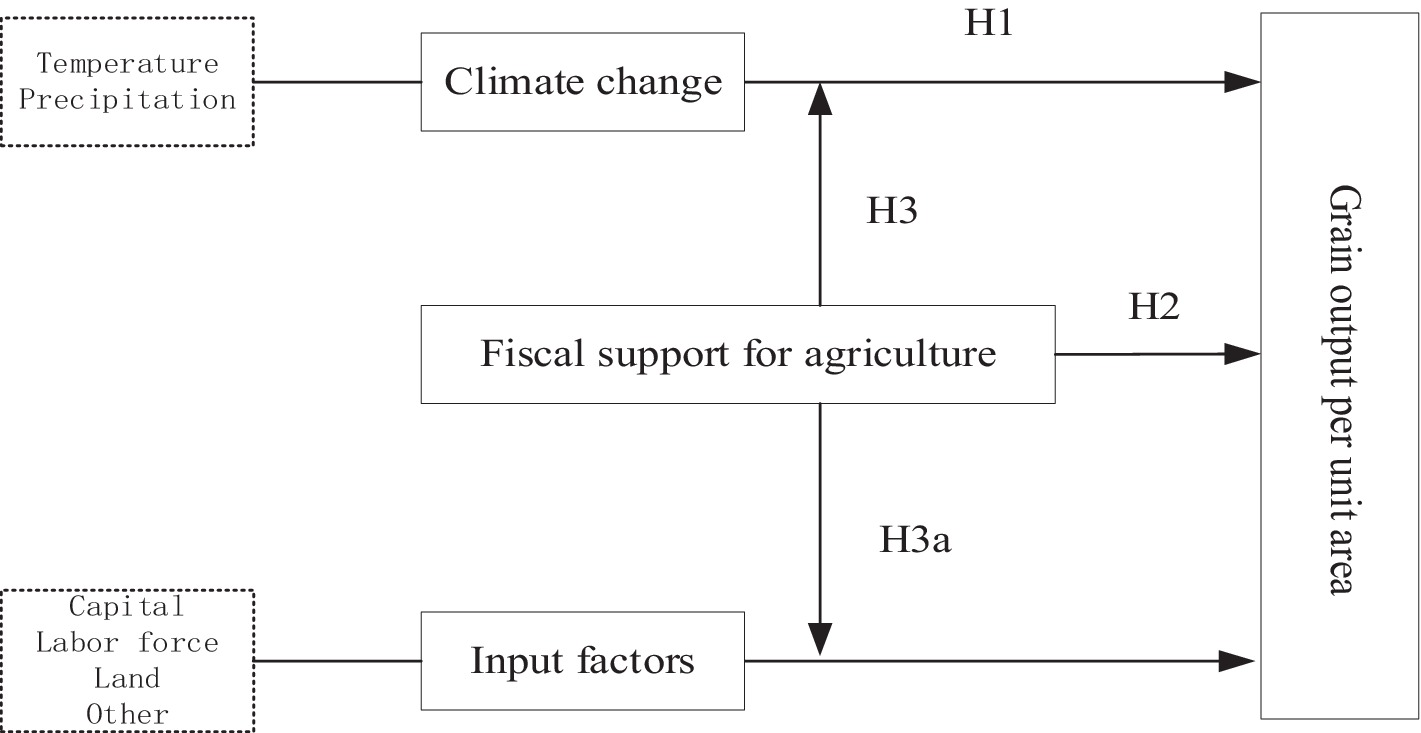
Figure 1. The theoretical framework of climate change, fiscal expenditure for agriculture, and crop yield.
2.2 Model specification and data sources
2.2.1 Model specification
Grain production is influenced by a multitude of factors, including major input elements such as fertilizer application, labor quantity, and agricultural machinery utilization, as well as climate factors like temperature and precipitation. Moreover, studies have indicated that the impact of climate on grain production exhibits nonlinear characteristics and is subject to regional environmental influences (Jianjun and Yan, 2013; Qingjiang and Jie, 2021). This implies that the influence of climate factors on grain production is not a simple linear relationship, but rather demonstrates nonlinear variation within a certain range. Additionally, varying environmental conditions across different regions lead to disparities in how climate factors affect grain production. Therefore, building upon the foundation of Shudong and Honggen (2010) research, this study has constructed the economic-climate model of the following equation (1), referencing the Cobb-Douglas production function.
In equation (1), i denotes cities, t represents years, s indicates crops, represents crop yield per unit area, represents annual temperature and precipitation, represents fiscal expenditure for agriculture, represents a set of control variables that can impact crop yield, represents time fixed effects, represents regional fixed effects, and represents the error term.
To examine the mechanism by which fiscal expenditure for agriculture addresses the impacts of climate change, the study employs the following model:
In equation (2), represents the interaction term between fiscal expenditure for agriculture and control variables. This interaction term is included to investigate the interplay between fiscal expenditure for agriculture and control variables, thus exploring the pathways through which fiscal expenditure for agriculture impacts crop yield under the influence of climate change. Furthermore, building upon equation (1), the interaction term between fiscal expenditure for agriculture and climate factors is introduced to investigate the role of fiscal expenditure for agriculture in addressing the impacts of climate change. The model is specified as follows:
In equation (3), represents the interaction term between fiscal expenditure for agriculture and climate factors. If the coefficient is significant, it indicates that fiscal expenditure for agriculture can play a role in addressing the i-th climate factor. Other variables are the same as those in equation (1).
Furthermore, building upon equation (1), the interaction term between climate factors and regional dummy variables is introduced to assess the degree to which grain crops in different regions are affected by climate change.
This study conducts empirical analysis using panel data from municipal levels in Heilongjiang Province from 2000 to 2020. Due to the long time span of 20 years, disturbances in the model may be accompanied by complex issues such as “between-group heteroscedasticity,” “within-group autocorrelation,” and “cross-sectional contemporaneous correlation.” The presence of heteroscedasticity and autocorrelation can weaken the effectiveness of parameter estimation. To verify the existence of these issues, Greene Wald test, Wooldridge Wald test, and Pesaran test are employed. The results indicate that disturbances in the model do indeed exhibit all three of the aforementioned issues. To address these problems, this study employs the comprehensive Feasible Generalized Least Squares (FGLS) method for model estimation. Compared to fixed effects and random effects models, FGLS is more flexible in handling heteroscedasticity, autocorrelation, and cross-sectional contemporaneous correlation issues in panel data. When heteroscedasticity and autocorrelation are present, fixed effects and random effects models may lead to biased parameter estimates, whereas FGLS is not constrained by these assumptions and can more effectively address heteroscedasticity and autocorrelation issues. Choosing FGLS not only corrects biases in parameter estimation but also enhances the robustness and reliability of the model, making the research results more convincing.
2.2.2 Measurement and description of variables
2.2.2.1 Dependent variables
is the dependent variable, representing the yield per unit area of a certain type of grain crop. It includes the yield per unit area of rice, wheat, and corn in the i-th city in the t-th year.
2.2.2.2 Key independent variables
Climate variables. The impact of climate on agricultural production is mainly reflected in temperature and precipitation. Considering that both the climate inside and outside the growing season are related to crop yields, and the climate prior to sowing also influences the planting period, this paper uses the annual average temperature and total precipitation as climate indicators to measure their impact on agricultural production. Figure 2 shows the climate change in Heilongjiang Province over the past 20 years. Although there have been fluctuations in annual precipitation and average annual temperature, there is an overall upward trend, especially in annual precipitation, which shows greater variability than average annual temperature.
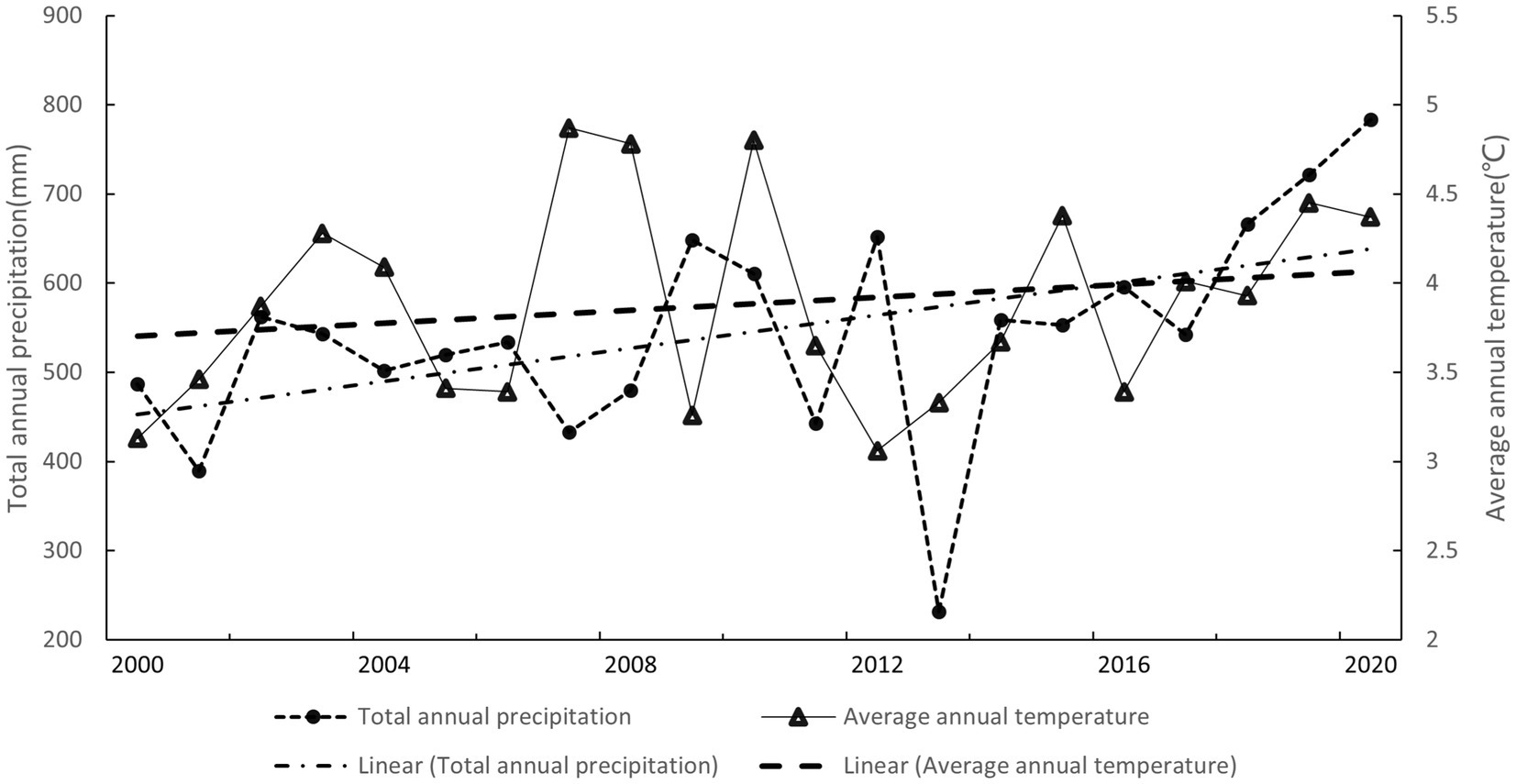
Figure 2. Climate change in Heilongjiang province over the last 20 years. The data is sourced from the “Heilongjiang Statistical Yearbook 2001–2021.”
Fiscal Expenditure for Agriculture. Fiscal expenditure for agriculture is represented in this study using data on agricultural fiscal expenditure from various cities in Heilongjiang Province. Given the extended time span and changes in statistical records, the study aggregates rural production support expenditure, comprehensive agricultural development expenditure, expenses related to agriculture, forestry, water, and meteorology, support for underdeveloped areas, and agricultural technology expenses as indicators of fiscal expenditure for agriculture. Due to data gaps for certain cities prior to 2010, the agricultural expenditure-to-GDP ratio reported in municipal statistical bulletins for that year is employed for estimation and conversion.
2.2.2.3 Control variables
These encompass agricultural labor input, agricultural machinery input, fertilizer input, cropping structure, and irrigation ratio. As the dependent variable under consideration is grain yield per unit area, preprocessing of control variables is necessary before model estimation.
Introducing regional dummy variables aims to control for the potential influence of unobservable factors at the municipal level on grain yield over time. Additionally, interaction terms between climate factors and regional dummy variables are employed to assess the differential impacts of climate change on grain yield across different regions. Based on the climate characteristics and distribution of grain-producing areas in Heilongjiang Province, Heilongjiang Province is divided into three geographical regions: the Sanjiang Plain, the Songnen Plain, and other areas. Using the Songnen Plain as the reference, corresponding regional dummy variables are set. The value is set to 1 if in that region and 0 otherwise. The Sanjiang Plain includes Jiamusi City, Jixi City, Hegang City, Shuangyashan City, and Qitaihe City; the Songnen Plain includes Harbin City, Qiqihar City, Suihua City, and Daqing City; and other areas include the Daxing’anling Region, Heihe City, Yichun City, and Mudanjiang City. Figure 3 shows the map of Heilongjiang Province, Figure 4 presents the temperature changes in various regions of Heilongjiang Province over the past 20 years, and Figure 5 shows the corresponding changes in annual precipitation for each region. From Figures 3, 4, it can be seen that although there have been fluctuations in annual precipitation and annual average temperature in various regions of Heilongjiang Province over the past 20 years, overall, they have shown an upward trend. In terms of annual average temperature, the Songnen Plain is the highest, followed by the Sanjiang Plain, and other areas are the lowest. The temperature change trend shows that the magnitude of increase in the Sanjiang Plain and other areas is the same, and both are higher than that of the Songnen Plain. In terms of annual precipitation, the Sanjiang Plain is the highest, followed by other areas, and the Songnen Plain is the lowest. In terms of precipitation change trends, the magnitude of change in the three regions is roughly equivalent.
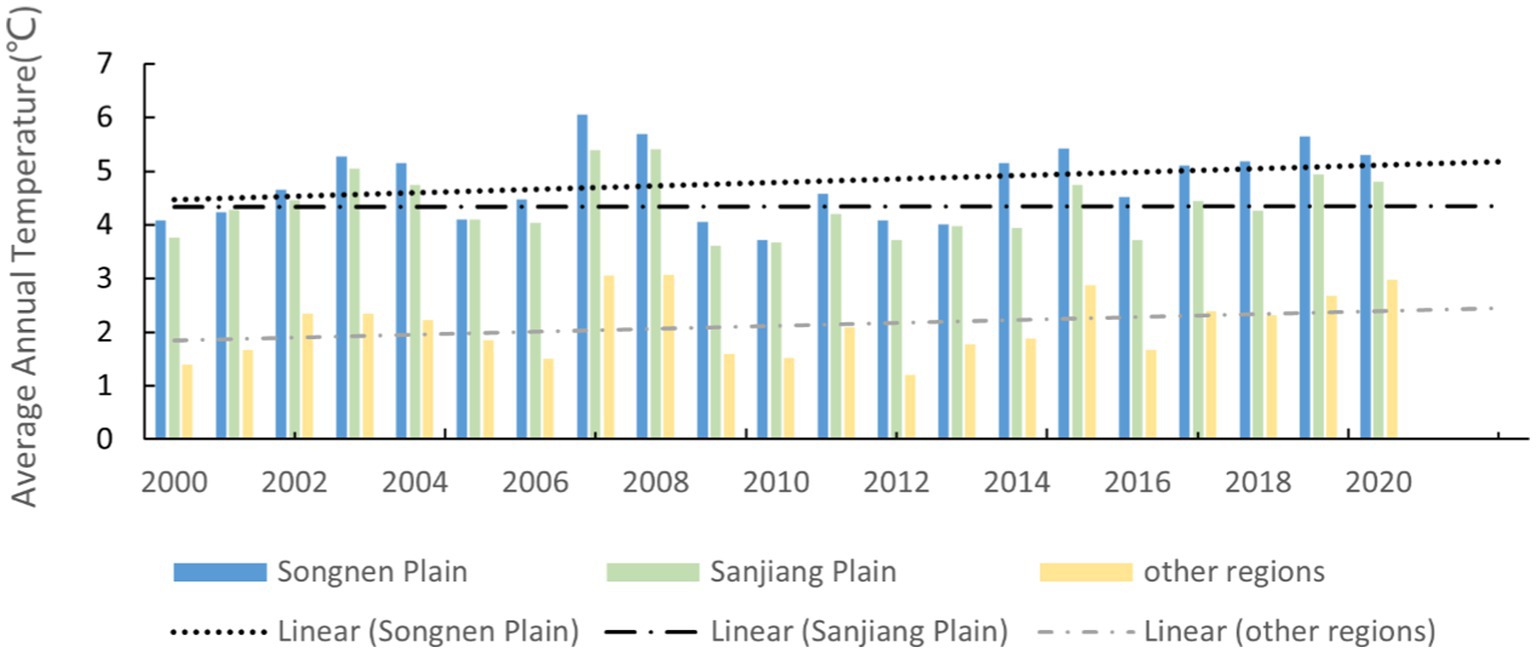
Figure 4. Temperature change in various regions of Heilongjiang province over 20 Years. The data is sourced from the “Heilongjiang Statistical Yearbook 2001–2021.”
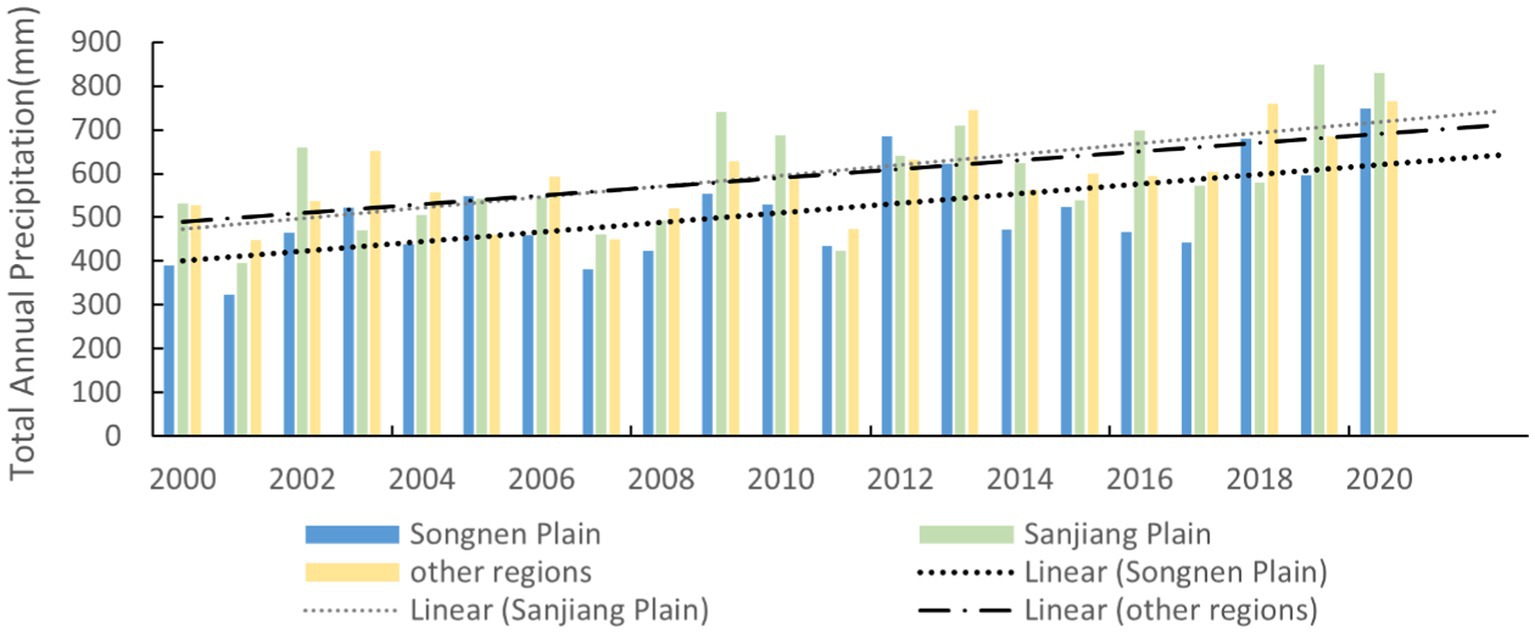
Figure 5. Precipitation change in various regions of Heilongjiang province over 20 Years. The data is sourced from the “Heilongjiang Statistical Yearbook 2001–2021.”
2.2.3 Data source and descriptive statistics
The dependent variable (grain yield) and control variables (total agricultural machinery power, fertilizer application, agricultural population, irrigation ratio, and agricultural structure) used in this study are all from the “Heilongjiang Statistical Yearbook” from 2001 to 2021. Climate variables, including annual average temperature (°C) and total annual precipitation (dm), are sourced from statistical entries on annual average temperature and annual precipitation in major cities (districts) in the “Heilongjiang Statistical Yearbook” and “Heilongjiang Yearbook” from 2001 to 2021. Due to missing data on agricultural fiscal expenditure for individual cities before 2010, the proportion of agricultural expenditure to GDP in the statistical bulletin of each city for that year is used for conversion. The data for each year are adjusted for inflation using the unchanged prices from 2000. The data used are from the “Heilongjiang Statistical Yearbook” and the statistical bulletins of various cities. Table 1 presents the descriptive statistics of the main variables in this empirical analysis.
For the subject of investigating climate change, a dataset spanning 21 years is relatively brief. However, constrained by Chinese statistical data, only data from 2000 to 2020 is available. Historical data beyond this period is lacking. To acquire data for additional years in order to explore the impact of climate change and fiscal expenditure for agriculture on crop yield, it might be necessary to wait for several years. Furthermore, climate change encompasses a multitude of factors; however, our study solely encompasses two climate variables: temperature and precipitation. While we aspired to incorporate other factors, most variables are absent in Chinese statistical data. The inclusion of these additional factors could even jeopardize the integrity of data spanning from 2000 to 2020. Striking a balance between the quantity of variables and the temporal scope, we opted for a focus on the temporal dimension.
3 Results and analysis
3.1 Analysis of baseline regression results
This section assesses the overall impact of climate change and fiscal expenditure for agriculture on grain production in Heilongjiang Province, with the estimation results presented in Table 2. Columns (1), (3), and (5) show the regression results without control variables, while other columns depict results after incorporating control variables. It is evident that with the inclusion of control variables, the regression coefficients for climate factors and fiscal expenditure for agriculture notably decrease. This indicates that economic variables can mitigate the influence of climate change on crop yield, substantiating Hypothesis H1.
When considering individual crops, columns (1) and (2) detail the regression results for the impact of climate change on rice yield. Both linear and quadratic terms of temperature and precipitation exhibit significance, suggesting a nonlinear effect of climate change on rice yield in Heilongjiang Province. The elasticity of temperature is 0.055 and is statistically significant at the 5% level, while the elasticity of precipitation is 0.976 and is significant at the 1% level, implying a positive promotion of rice yield due to climate change. The quadratic coefficients indicate a U-shaped relationship between temperature and rice yield, with the temperature of the curve’s nadir at 0.067. This value falls within the temperature range of 0.01 to 6.62, indicating that a continued rise in temperature is favorable for rice cultivation and increased yield. Precipitation’s impact on rice yield follows an inverted U-shaped pattern, revealing an optimal turning point. The corresponding annual precipitation total at this turning point is 54.1 dm, within the range of precipitation values (24.9–113).
Columns (3) and (4) present the regression results of climate change on wheat yield. In the absence of control variables, climate change’s impact on wheat yield is not statistically significant. However, upon integrating control variables, only temperature significantly influences wheat yield, with an elasticity of-0.158 and statistical significance at the 5% level. This suggests that irrespective of input variations, climate change is consistently detrimental to wheat production in Heilongjiang Province. Consequently, under scenarios of continuous warming, wheat cultivation in Heilongjiang should be reduced.
Columns (5) and (6) display the regression results for the impact of climate change on maize yield. The significance and coefficients of climate variables correspond with those of rice, signifying a favorable impact of climate change on maize cultivation and yield enhancement. Specifically, the temperature elasticity is 0.121 and is significant at the 1% level. The quadratic coefficient for temperature indicates a U-shaped effect, with the optimal temperature at 0.056. This value falls within the temperature range of 0.01 to 6.62, indicating a conducive environment for maize cultivation and increased yield under a continued rise in temperature. The elasticity of precipitation is 1.324 and is significant at the 1% level. The quadratic coefficient for precipitation indicates a negative impact, suggesting an inverted U-shaped relationship. The positive effect of precipitation on maize yield begins to wane when the annual precipitation total reaches 55.2 dm. The impact of climate change on the yield of the three crops in Heilongjiang Province varies, substantiating Hypothesis H1.
For all three crops, fiscal expenditure for agriculture significantly and positively promotes crop yield, with regression coefficients remaining statistically significant across different levels of significance. Specifically, the elasticity of fiscal expenditure for rice is 0.035, for wheat it is 0.103, and for maize it is 0.05. This confirms the role of fiscal expenditure for agriculture in enhancing grain crop production, supporting Hypothesis H2.
3.2 Effects of fiscal expenditure for agriculture
3.2.1 Regulatory role of fiscal expenditure for agriculture on crop yield
Fiscal expenditure for agriculture plays a role at the macro level in influencing crop yield, primarily manifested through adjustments in planting structure and alterations in production inputs. Specifically, the adjustment of planting structure refers to government actions, represented by fiscal expenditure for agriculture, in planning crop cultivation to address the impacts of climate change on crop yield, thereby adapting to the long-term effects of climate change on grain crop yield. Changing production inputs, on the other hand, pertains to the influence of fiscal expenditure for agriculture on traditional production factors in the context of climate change. This mainly encompasses capital and labor inputs (Zhang et al., 2024), coupled with the spontaneous adaptive behaviors adopted by farmers during production and the principal direction of fiscal expenditure for agriculture. This study emphasizes the impact of fiscal expenditure for agriculture on labor and machinery inputs.
As indicated in Table 3, fiscal expenditure for agriculture can affect crop yield by adjusting maize planting structure and by influencing labor and machinery inputs for all three crops (Zhang et al., 2024). Specifically, the interaction between fiscal expenditure for agriculture and the planting structure has a significantly negative impact on maize yield, while no substantial effect is observed on rice and wheat yields. This suggests that increased investment in adjusting planting structure could yield unfavorable outcomes. The interaction between fiscal expenditure for agriculture and labor input significantly negatively impacts the yield of all three crops. For crop yield, high output entails achieving higher yields with fewer inputs. Fiscal expenditure for agriculture can reduce labor input during crop production, thereby enhancing yield. In the context of climate change, fiscal expenditure for agriculture can alter labor input to favor increased crop yield. Similarly, given the high level of comprehensive mechanization in grain crop cultivation in Heilongjiang Province, increased fiscal expenditure for agriculture would restrain the positive impact of machinery input on crop yield. This suggests that the existing machinery power meets production requirements and that future fiscal expenditure for agriculture should be directed toward other categories, thereby enhancing grain crop yield. In summary, hypothesis H3a is confirmed.
3.2.2 Effects of fiscal expenditure for agriculture in responding to climate change
Table 4 presents the regression results concerning the effects of fiscal expenditure for agriculture in responding to climate change. The odd-numbered columns display the results without controlling for variables, while the even-numbered columns show the results after incorporating control variables. The findings indicate that fiscal expenditure for agriculture has a significant positive impact on the yield of rice, wheat, and maize. These results are consistent with the baseline regression, suggesting the robustness of this variable’s influence. Fiscal expenditure for agriculture is capable of enhancing crop yield. The interaction between fiscal expenditure for agriculture and temperature does not exert a significant impact on the yield of all three crops. However, the interaction between fiscal expenditure for agriculture and precipitation has a significant positive effect on rice and maize yield at the 1% statistical significance level, but its positive impact on wheat is not significant. This implies that fiscal expenditure for agriculture reinforces the positive impact of precipitation on crop yield for these three crops, while its effectiveness in mitigating the impact of temperature on crop yield is less pronounced.
In more detail, fiscal expenditure for agriculture amplifies the marginal positive effect of temperature on rice yield by 23.53 to 37.29%, although insignificantly. It also enhances the marginal positive effect of precipitation on rice yield by 18.08 to 21.07%, significantly at the 1% level. Its role in addressing climate change’s impact on wheat yield is less discernible. For maize, fiscal expenditure for agriculture reduces the marginal positive effect of temperature by 39.17%, significantly at the 5% level, although this significance diminishes when control variables are introduced, suggesting its limited effect in responding to temperature changes in maize yield. It amplifies the marginal positive effect of precipitation on maize yield by 15.42 to 18.26%, significantly at the 5% level. In conclusion, the role of fiscal expenditure for agriculture in addressing climate change has not achieved the anticipated results. Potential reasons include the predetermined nature of fiscal expenditure for agriculture, making it less responsive to unforeseen events, as well as the lagged effect of such expenditure (Wang et al., 2022). Furthermore, different crops require distinct growth environments, leading to varying effects of fiscal expenditure for agriculture on the yield response to climate change.
3.3 Heterogeneity analysis
Based on the distribution of grain production regions, Heilongjiang Province is divided into the Sanjiang Plain, Songnen Plain, and other regions, with the Songnen Plain as the reference. Using interaction terms, we investigate the impact of climate change on crop yield in these three regions and conduct intra-group comparisons. Based on specific climatic conditions, Heilongjiang Province is categorized into the Songnen Plain and non-Songnen Plain regions. We utilize grouped regression to examine the effect of climate change on crop yield in these two climatic zones and conduct inter-group comparisons. The results are presented in Table 5, with columns (1)–(3) displaying the results with interaction terms and columns (4)–(9) displaying the results of grouped regression.
The results of interaction term regressions reveal that the interaction term between temperature and the Sanjiang Plain and other regions does not have a significant impact on the yield of the three crops. However, the interaction term between precipitation and these regions significantly and positively affects the crop yield at various levels of statistical significance. This implies that temperature does not exhibit noticeable heterogeneity across different regions, while precipitation does have a significant heterogeneous effect. This may be due to the fact that, despite the rapid warming rate in Heilongjiang, certain areas, such as the Sanjiang Plain, do not yet meet the requirements for large-scale cultivation of staple crops due to insufficient accumulated temperature. On the other hand, precipitation displays substantial inter-annual variability and significant spatial–temporal differences, leading to distinct regional disparities in its impact on crop growth. Looking at specific crops, temperature has a significantly positive effect on rice yield in the Songnen Plain, with an elasticity coefficient of 0.178 and significant at the 10% level. The impact of temperature on rice yield in the Sanjiang Plain and other regions is lower than that in the Songnen Plain, while the impact of precipitation on rice yield in the Sanjiang Plain and other regions is higher than that in the Songnen Plain. This is because rice cultivation requires an adequate water supply, and an increase in future precipitation has a positive effect on rice production in Heilongjiang. Additionally, the accumulated temperature suitable for rice growth is around 2,700°C, and the continuous increase in temperature in the future can expand the area of rice cultivation, thereby improving rice yield. Heilongjiang plants spring wheat, and the low temperature and drought in spring have a negative impact on wheat yield in Heilongjiang. Precipitation has a significantly positive effect on wheat yield in the Sanjiang Plain and other regions. Compared to the effect of climate change on maize yield in the Songnen Plain, the positive impact of precipitation on maize yield in the Sanjiang Plain and other regions is more significant, which is consistent with the research conclusions of Huang et al. (2017). Climate change favors the improvement of maize yield in Heilongjiang.
Group regression results indicate that the impact of climate change on crop yields varies significantly across different regions. Overall, temperature has a significantly positive effect on rice and maize production in non-Songnen Plain regions, while precipitation has a significantly positive effect on rice and maize production in the Songnen Plain region. However, precipitation has a significantly negative effect on wheat yield in non-Songnen Plain regions (Huang et al., 2017). The reasons for these significant differences are as follows: Firstly, the agricultural production conditions in the Songnen Plain are favorable, as it is one of the world’s three major black soil belts with fertile soil. Secondly, the Songnen Plain is one of China’s important commodity grain bases with well-developed agricultural infrastructure and advanced agricultural technology. Thirdly, the climate in the Songnen Plain is suitable, with sufficient accumulated temperature throughout the year for the cultivation of grain crops, although precipitation is slightly insufficient year-round. An increase in precipitation would have a positive effect on grain crop yields (Du et al., 2016). Specifically, for the Songnen Plain, precipitation has a positive impact on rice yield with an elasticity coefficient of 0.976 and statistical significance at the 1% level. However, the impact of temperature on rice yield in the Songnen Plain is adverse. This finding is generally in line with the conclusions of Wenhui et al. (2020). This could be attributed to the Songnen Plain having a temperate monsoon climate characterized by high temperatures and heavy rainfall in summer, and cold and dry conditions in autumn, which makes it prone to drought and pest infestations. Temperature positively affects rice yield in non-Songnen Plain regions with an elasticity coefficient of 0.087 and statistical significance at the 1% level. Meanwhile, the impact of precipitation on rice yield in these regions is adverse, indicating that the lower accumulated temperature in non-Songnen Plain regions causes climate change to elevate temperature conditions suitable for rice cultivation, while increased precipitation poses a threat to rice cultivation in these areas. The adverse impact of temperature on both the Songnen Plain and non-Songnen Plain suggests that the current climatic conditions in Heilongjiang are not suitable for large-scale wheat cultivation. The effects of climate change on maize yield in the Songnen Plain and non-Songnen Plain are similar to those on rice yield, with temperature exhibiting an elasticity of 0.160 and statistical significance at the 1% level.
In conclusion, considering grain production regions, climate change benefits rice and maize yield in the Sanjiang Plain and other regions, but is unfavorable for extensive wheat cultivation. Examining specific climatic characteristics, climate change predominantly negatively affects the Songnen Plain, while it positively impacts rice and maize yield in the non-Songnen Plain.
3.4 Robustness test
This study conducts robustness tests from two perspectives. Firstly, a stepwise regression approach is employed. The results indicate that the direction of the core explanatory variables remains relatively stable. As each control variable is successively introduced, the numerical values of the core explanatory variables decrease overall. This suggests that the influence of climate change on crop yield diminishes when socioeconomic variables are incorporated. Secondly, model replacement is undertaken to verify the robustness of the findings. Considering the presence of heteroskedasticity and contemporaneous correlation issues, this study employs the “Panel-Corrected Standard Errors” (PCSE) estimation method to examine the benchmark regression outcomes. Detailed regression results are presented in Table 6. With minor variations in the magnitude of coefficients for individual explanatory variables, the signs and significance levels remain largely consistent with those in Table 3, confirming the robustness of the conclusions drawn in this study.
4 Conclusion and discussion
4.1 Conclusion and recommendations
Examining the impact of climate change and fiscal expenditure for agriculture on grain production in Heilongjiang Province contributes to the formulation of effective strategies to address climate change, ensuring domestic grain production in China, and alleviating international food supply pressures. Based on panel data from municipal levels in Heilongjiang Province for the period 2000–2020, this study integrates climate factors and fiscal expenditure for agriculture into a unified framework. Empirical analyses are conducted using the Fixed-Effect Generalized Least Squares (FGLS) model to investigate the influence of climate change and fiscal expenditure for agriculture on grain production, as well as the role of fiscal expenditure for agriculture in mitigating the effects of climate change. The following conclusions are drawn: (1) Climate change and fiscal expenditure for agriculture have significant positive effects on the yield of staple crops. (2) Climate change favors expanded cultivation of rice and maize in Heilongjiang Province but is unfavorable for wheat cultivation. Specifically, temperature exhibits a significant positive linear relationship with rice and maize yields, while precipitation demonstrates a significant inverted U-shaped impact on rice and maize yields. Temperature negatively affects wheat yield. (3) Fiscal expenditure for agriculture plays an effective role in mitigating the impact of climate change on grain crop yields, specifically by enhancing the positive effect of precipitation on the yields of maize and rice. (4) Climate factors exhibit regional disparities in their effects on grain crop yields, where climate change is detrimental to regions with favorable production conditions such as the Songnen Plain, but beneficial to colder regions like the Sanjiang Plain.
Based on the conclusions of this study, the following recommendations are provided: (1) Given the long-term impact of climate change on the production of major grain crops in Heilongjiang Province, policymakers should deepen their understanding of the patterns of climate change effects. This includes understanding regional differences in crop yields under different climatic conditions and developing long-term adaptation strategies for major crops such as rice, maize, and wheat; (2) Based on the research findings, the government should adjust fiscal expenditure for agriculture, increase investment in rural infrastructure and meteorological forecasting, and enhance farmers’ capacity to adapt to climate change. At the same time, support should be focused on agricultural development in areas with poorer production environments to mitigate the negative impacts of climate change; (3) Considering the differential effects of climate change on different crops, the government should adopt a more flexible approach in future policies on crop structure. Adaptation of crops such as rice, maize, and wheat to climate change should be taken into account, and farmers should be encouraged to adjust their planting structures based on climatic conditions to enhance the overall stability of the agricultural system; (4) The government should enhance support for agricultural research and promote the development and adoption of new varieties to address the long-term impacts of climate change on crop production. Furthermore, efforts should be made to encourage the transition of agricultural production methods in different regions, cultivating new varieties with high adaptability and strong resistance to disasters to tackle the challenges posed by climate change.
5 Discussion
This study comprehensively examines the current status of agricultural production in Heilongjiang Province against the backdrop of climate change and analyzes the role of fiscal expenditure for agriculture in mitigating these impacts. Empirical research indicates that fiscal expenditure for agriculture plays a positive role in addressing the effects of climate change on agricultural production. In the context of global climate change, the findings of this study provide important guidance for policymakers. However, it must be emphasized that agricultural fiscal expenditure policies may not always yield positive effects and may sometimes even lead to a range of issues. For instance, some agricultural fiscal expenditure policies may result in overexploitation of resources, exacerbate environmental pollution, and consequently degrade the ecological environment in rural areas. Therefore, future research is necessary to delve deeper into the design and implementation of agricultural fiscal expenditure policies to achieve a balance between agricultural production and environmental protection. Future research can focus on the following directions: Firstly, further explore the long-term effects of fiscal expenditure on agricultural production, especially in the context of climate change, to understand the continuous fiscal support’s impact on the stability and resilience of agricultural systems. Secondly, explore adaptive strategies for crops, such as improving varieties and optimizing planting structures, to cope with climate change. Additionally, the role of technological innovation in enhancing crop resilience is crucial, and research should focus on the application of new technologies in crop growth to enhance the resilience of agricultural systems.
Our study focuses on Heilongjiang Province. Although it is a major grain-producing region in China, the generalizability of the research still needs further exploration. We hope that future research can expand to a broader geographical area, including other countries and regions, to conduct similar empirical studies to validate and deepen our research findings. Methodologically, we constructed an economic climate model using the Cobb–Douglas production function and successfully addressed issues such as heteroscedasticity, autocorrelation, and contemporaneous cross-sectional correlation using feasible generalized least squares. This method provides important reference for future research on the economic impact of climate change on agricultural production. Model validation results show that the model effectively captures the differences in agricultural production changes in different regions of Heilongjiang Province. Based on the above research, future studies can further explore and develop more refined and complex models to more accurately analyze the impact of climate change on agricultural production.
Data availability statement
The raw data supporting the conclusions of this article will be made available by the authors, without undue reservation.
Author contributions
WH: Software, Methodology, Writing – review & editing, Writing – original draft. JY: Writing – original draft, Software. XH: Writing – review & editing, Conceptualization. ZZ: Writing – original draft, Investigation. ZS: Writing – original draft, Investigation. HZ: Writing – original draft, Methodology, Conceptualization.
Funding
The author(s) declare financial support was received for the research, authorship, and/or publication of this article. This project is financially supported by “The Agricultural Science and Technology Innovation Program (10-IAED-01-2024).”
Acknowledgments
We would like to express our gratitude to Associate Professor Jiping Ding from the School of Economics and Management at Northwest A&F University, and Professor Yangjie Wang from the Business School at Central South University, for their meticulous revisions of this paper. Their valuable contributions have significantly enhanced the quality of this manuscript.
Conflict of interest
The authors declare that the research was conducted in the absence of any commercial or financial relationships that could be construed as a potential conflict of interest.
Publisher’s note
All claims expressed in this article are solely those of the authors and do not necessarily represent those of their affiliated organizations, or those of the publisher, the editors and the reviewers. Any product that may be evaluated in this article, or claim that may be made by its manufacturer, is not guaranteed or endorsed by the publisher.
References
Abbas, A., Bhatti, A. S., Ullah, S., Ullah, W., Waseem, M., Zhao, C., et al. (2023). Projection of precipitation extremes over South Asia from CMIP6 GCMs. J. Arid. Land 15, 274–296. doi: 10.1007/s40333-023-0050-3
Abbas, A., Waseem, M., Ahmad, R., khan, K. A., Zhao, C., and Zhu, J. (2022a). Sensitivity analysis of greenhouse gas emissions at farm level: case study of grain and cash crops. Environ. Sci. Pollut. Res. 29, 82559–82573. doi: 10.1007/s11356-022-21560-9
Abbas, A., Zhao, C., Waseem, M., Ahmed khan, K., and Ahmad, R. (2022b). Analysis of energy input–output of farms and assessment of greenhouse gas emissions: a case study of cotton growers. Front. Environ. Sci. 9:826838. doi: 10.3389/fenvs.2021.826838
Alston, J. M., Andersen, M. A., James, J. S., and Pardey, P. G. (2010). Persistence pays: US agricultural productivity growth and the Benefits from Public R & D Spending. doi: 10.1007/978-1-4419-0658-8,
Binlei, G., and Shuo, W. (2021). The multiple pathways of fiscal expenditure on China's agricultural growth. Iss. Agricul. Econ. 1, 54–68,
Bollington, A., DeLonge, M., Mungra, D., Hayek, M., Saifuddin, M., and McDermid, S. S. (2021). Closing research investment gaps for a global food transformation. Front. Sustain. Food Syst. 5:794594. doi: 10.3389/fsufs.2021.794594
Carter, R., Choularton, R., Ferdinand, T., et al. (2021). Food systems at risk: transformative adaptation for long-term food security. doi: 10.46830/wrirpt.19.00042,
Challinor, A. J., Watson, J., Lobell, D. B., Howden, S. M., Smith, D. R., and Chhetri, N. (2014). A meta-analysis of crop yield under climate change and adaptation. Nat. Clim. Chang. 4, 287–291. doi: 10.1038/nclimate2153
Chaojing, Y., Gucheng, L., Lixia, F., and Xue, G. (2016). Climate change, technological stock, and agricultural productivity growth. Chin. Rural Econ. 5, 16–28,
Chen, S., Chen, X., and Xu, J. (2016). Impacts of climate change on agriculture: evidence from China. J. Environ. Econ. Manag. 76, 105–124. doi: 10.1016/j.jeem.2015.01.005
Chen, J., Liu, Y., Pan, T., Ciais, P., Ma, T., Liu, Y., et al. (2020). Global socioeconomic exposure of heat extremes under climate change. J. Clean. Prod. 277:123275. doi: 10.1016/j.jclepro.2020.123275
De Janvry, A., and Sadoulet, E. (2010). Agricultural growth and poverty reduction: additional evidence. World Bank Res. Obs. 25, 1–20. doi: 10.1093/wbro/lkp015
Du, G. M., Zhang, L. Y., Xu, X. L., et al. (2016). Spatiotemporal evolution analysis of maize production potential in Northeast China driven by climate over the past 50 years. Geogr. Res. 35, 864–874,
Editorial Committee of the “China Rural Statistical Yearbook—2021” (2021). Chief editor Li Suoqiang. China rural statistical yearbook. Beijing, China: China Statistics Press.
Elahi, E., Khalid, Z., and Zhang, Z. (2022). Understanding farmers’ intention and willingness to install renewable energy technology: a solution to reduce the environmental emissions of agriculture. Appl. Energy 309:118459. doi: 10.1016/j.apenergy.2021.118459
Elahi, E., Li, G., Han, X., Zhu, W., Liu, Y., Cheng, A., et al. (2024). Decoupling livestock and poultry pollution emissions from industrial development: a step towards reducing environmental emissions. J. Environ. Manag. 350:119654. doi: 10.1016/j.jenvman.2023.119654
Evenson, R. E., and Gollin, D. (2003). Assessing the impact of the green revolution, 1960 to 2000. Science 300, 758–762.
Fujin, Y., Tiantian, Z., and Xiaoguang, C. (2021). Climate change, agricultural research investment, and agricultural total factor productivity. J. Nanjing Agricul. Univ. 21, 155–167,
Gao, Y., Shu, Y., Cao, H., Zhou, S., and Shi, S. (2021). Fiscal policy dilemma in resolving agricultural risks: evidence from China’s agricultural insurance subsidy pilot. Int. J. Environ. Res. Public Health 18:7577. doi: 10.3390/ijerph18147577
Hong, X., and Jinwei, Z. (2020). Green technology advancement effects of R&D investment - based on the perspective of technological progress direction at the urban level. China Popul. Resour. Environ. 30, 121–128,
Huang, Z. G., Xiao, Y., Zhang, G., et al. (2017). Estimation and prediction of irrigation water requirement for maize in the Songnen plain under the background of climate change. J. Ecol. 37, 2368–2381,
Jayne, T. S., and Rashid, S. (2013). Input subsidy programs in sub-Saharan Africa: a synthesis of recent evidence. Agric. Econ. 44, 547–562. doi: 10.1111/agec.12073
Jia, H. C., and Pan, D. H. (2016). Drought risk assessment in Yunnan province of China based on wavelet analysis. Adv. Meteorol. 2016, 1–10. doi: 10.1155/2016/1579415
Jiangbo, G., Lulu, L., Linghui, G., Dongqi, S., Wanlu, L., Hou Wenjuan, W., et al. (2022). The synergistic effects of climate change and phenological changes on agricultural production in Northeast China's black soil region and future food production risks. Acta Geograph. Sin. 77, 1681–1700,
Jianjun, X., and Yan, X. (2013). Comparative study of the effect of fiscal support on grain output. Fiscal Res. 1, 54–57,
Jianying, J., and Jianping, G. (2011). Analysis of climate change characteristics in Northeast China over the past 46 years. J. Arid Land Res. Enviro. 25, 109–115,
Jieming, C., Wenjie, D., and Duzheng, Y. (2006). Construction of a new economic-climate model. Chin. Sci. Bull. 14, 1735–1736,
Juncong, C., Huaiming, W., and Yingmei, T. (2016). Climate change, agricultural insurance, and China's food security. Rural Econ. 12, 9–15,
Kawishe, P. T., and Mallya, E. T. (2022). Politics and agricultural policy implementation in Tanzania. J. Polit. Pol. 4, 32–50. doi: 10.21776/ub.jppol.2022.004.01.03
Le, Z., and Fusheng, Z. (2018). The impact of rural infrastructure on total factor productivity of grain. Agricul. Technol. Econ. 11, 92–101,
Lin, Y., Wu, W., and Ge, Q. (2015). CERES-maize model-based simulation of climate change impacts on maize yields and potential adaptive measures in Heilongjiang Province, China. J. Sci. Food Agric. 95, 2838–2849. doi: 10.1002/jsfa.7024
Liu, B., Asseng, S., Müller, C., Ewert, F., Elliott, J., Lobell, D. B., et al. (2016). Similar estimates of temperature impacts on global wheat yield by three independent methods. Nat. Clim. Chang. 6, 1130–1136. doi: 10.1038/nclimate3115
Liu, D., Li, Y., Wang, P., Zhong, H., and Wang, P. (2021). Sustainable agriculture development in Northwest China under the impacts of global climate change. Front. Nutr. 8:706552. doi: 10.3389/fnut.2021.706552
Liu, Y., Li, N., Zhang, Z., Huang, C., Chen, X., and Wang, F. (2020). Climate change effects on agricultural production: the regional and sectoral economic consequences in China. Earth. Fut. 8:e2020EF001617. doi: 10.1029/2020EF001617
Lobell, D. B., and Gourdji, S. M. (2012). The influence of climate change on global crop productivity. Plant Physiol. 160, 1686–1697. doi: 10.1104/pp.112.208298
Lupeng, G., Wenju, L., Jun, Z., Fanxiang, M., Yong, J., and Dazhong, W. (2005). Simulating the impact of climate change on the organic carbon pool in black soil. J. Liaoning Tech. Univ. 2, 288–291,
Mendelsohn, R., Dinar, A., and Sanghi, A. (2001). The effect of development on the climate sensitivity of agriculture. Environ. Dev. Econ. 6, 85–101. doi: 10.1017/S1355770X01000055
Keqiang, P., and Xinhua, L. (2010). Empirical analysis of the relationship between China's fiscal support for agriculture and grain production capacity. Agricul. Technol. Econ. 9, 18–29,
Qingjiang, H., and Jie, X. (2021). Regional differences and dynamic evolution of fiscal support for agriculture - taking China's main grain-producing areas as an example. Res. Technol. Econ. Manag. 7, 92–96,
Ray, D. K., Gerber, J. S., MacDonald, G. K., and West, P. C. (2015). Climate variation explains a third of global crop yield variability. Nat. Commun. 6:5989. doi: 10.1038/ncomms6989
Salazar, L., Kogan, F., and Roytman, L. (2007). Use of remote sensing data for estimation of winter wheat yield in the United States. Int. J. Remote Sens. 28, 3795–3811. doi: 10.1080/01431160601050395
Salim, R. A., and Islam, N. (2010). Exploring the impact of R&D and climate change on agricultural productivity growth: the case of Western Australia. Aust. J. Agric. Resour. Econ. 54, 561–582. doi: 10.1111/j.1467-8489.2010.00514.x
Schlenker, W., and Lobell, D. B. (2010). Robust negative impacts of climate change on African agriculture. Environ. Res. Lett. 5:014010. doi: 10.1088/1748-9326/5/1/014010
Schlenker, W., and Roberts, M. J. (2009). Nonlinear temperature effects indicate severe damages to US crop yields under climate change. Proc. Natl. Acad. Sci. 106, 15594–15598. doi: 10.1073/pnas.0906865106
Shudong, Z., and Honggen, Z. (2010). The economic impact of climate change on rice production in southern China and its adaptation strategies. China Popul. Resour. Environ. 20, 152–157,
Tao, F., Yokozawa, M., and Zhang, Z. (2009). Modelling the impacts of weather and climate variability on crop productivity over a large area: a new process-based model development, optimization, and uncertainties analysis. Agric. For. Meteorol. 149, 831–850. doi: 10.1016/j.agrformet.2008.11.004
Tao, F., Zhang, Z., Zhang, S., and Rötter, R. P. (2015). Heat stress impacts on wheat growth and yield were reduced in the Huang-Huai-Hai plain of China in the past three decades. Eur. J. Agron. 71, 44–52. doi: 10.1016/j.eja.2015.08.003
Tuanbiao, J., and Lin, L. (2022). Fiscal support for agriculture and food security - an empirical analysis based on regional differences. World Agricul. 2, 66–79,
Ullah, W., Karim, A., Ullah, S., Rehman, A. U., Bibi, T., Wang, G., et al. (2023). An increasing trend in daily monsoon precipitation extreme indices over Pakistan and its relationship with atmospheric circulations. Front. Environ. Sci. 11:1228817. doi: 10.3389/fenvs.2023.1228817
Wang, S., Zhu, J., Wang, L., and Zhong, S. (2022). The inhibitory effect of agricultural fiscal expenditure on agricultural green total factor productivity. Sci. Rep. 12:20933. doi: 10.1038/s41598-022-24225-2
Waseem, M., Khurshid, T., Abbas, A., Ahmad, I., and Javed, Z. (2022). Impact of meteorological drought on agriculture production at different scales in Punjab, Pakistan. J. Water Climate Change 13, 113–124. doi: 10.2166/wcc.2021.244
Wenhui, J., Bo, Z., Yanqiang, C., Liting, X., Hao, H., and Xiaodan, W. (2020). Analysis of the drought characteristics of spring maize in the Songnen plain in the past 57 years. Res. Soil Water Conserv. 27, 324–331,
Wijeratne, V. P. I. S., Li, G., Mehmood, M. S., and Abbas, A. (2022). Assessing the impact of long-term ENSO, SST, and IOD dynamics on extreme hydrological events (EHEs) in the Kelani River basin (KRB), Sri Lanka. Atmos. 14:79. doi: 10.3390/atmos14010079
Wu, Y., Wang, E., and Miao, C. (2019). Fertilizer use in China: the role of agricultural support policies. Sustain. For. 11:4391. doi: 10.3390/su11164391
Xuan, X., Liu, B., and Zhang, F. (2021). Climate change and adaptive management: case study in agriculture, forestry and pastoral areas. Land 10:832. doi: 10.3390/land10080832
Yafen, W., Shixing, Z., and Tiemei, G. (2015). Research on the effect of China's financial support for "three rural" policy. Fin. Econ. 9, 85–92,
Yang, T., Chandio, A. A., Zhang, A., and Liu, Y. (2023). Do farm subsidies effectively increase grain production? Evidence from major grain-producing regions of China. Food Secur. 12:1435. doi: 10.3390/foods12071435
Yixuan, Z., and Zhongjian, L. (2022). Fiscal support for agriculture, inclusive financial development and farmer income increase: heterogeneity research based on six provinces in Central China. Econ. Iss. Explor. 4, 180–190,
Zhang, Z., Chen, Y. H., and Tian, Y. (2024). Effect of agricultural fiscal expenditures on agricultural carbon intensity in China. Environ. Sci. Pollut. Res. 31, 10133–10147. doi: 10.1007/s11356-023-25763-6
Zhao, Q., Bao, H. X. H., and Zhang, Z. (2021). Off-farm employment and agricultural land use efficiency in China. Land Use Policy 101:105097. doi: 10.1016/j.landusepol.2020.105097
Zhao, C., Liu, B., Piao, S., Wang, X., Lobell, D. B., Huang, Y., et al. (2017). Temperature increase reduces global yields of major crops in four independent estimates. Proc. Natl. Acad. Sci. 114, 9326–9331. doi: 10.1073/pnas.1701762114
Zhixin, Z., Cheng, L., and Haiyang, B. (2022). The impact of agricultural infrastructure on food production efficiency. East China Econ. Manag. 36, 100–109,
Keywords: effect climate change, fiscal expenditure for agriculture, grain yield, moderating effect, policy proposals
Citation: Hao W, Yang J, Hu X, Zhang Z, Shi Z and Zhou H (2024) Can fiscal expenditure for agriculture mitigate the impact of climate change on agricultural production? Front. Sustain. Food Syst. 8:1349840. doi: 10.3389/fsufs.2024.1349840
Edited by:
Josef Abrham, Czech University of Life Sciences Prague, CzechiaReviewed by:
Xiaolong Feng, China Agricultural University, ChinaAdnan Abbas, Nanjing University of Information Science and Technology, China
Copyright © 2024 Hao, Yang, Hu, Zhang, Shi and Zhou. This is an open-access article distributed under the terms of the Creative Commons Attribution License (CC BY). The use, distribution or reproduction in other forums is permitted, provided the original author(s) and the copyright owner(s) are credited and that the original publication in this journal is cited, in accordance with accepted academic practice. No use, distribution or reproduction is permitted which does not comply with these terms.
*Correspondence: Hui Zhou, emhvdWh1aUBjYWFzLmNu
†These authors share first authorship
 Wang Hao
Wang Hao Jianqing Yang2†
Jianqing Yang2† Xiangdong Hu
Xiangdong Hu Zizhong Shi
Zizhong Shi